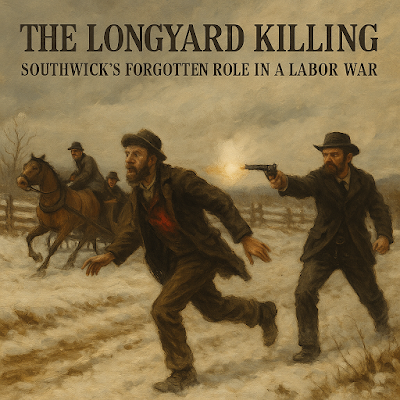Revolt: Fight in the Longyard
In 1868, a labor dispute in Westfield’s cigar industry exploded into a dramatic—and deadly—conflict. And before it was over, threats had turned into violence, police were chasing fugitives, and a bullet fired in Southwick would bring the whole thing to a shocking end.
It all started with one woman.
A Factory, a Union, and One Bold Hire
Harrison & Carpenter was one of the largest cigar manufacturers in Westfield, Massachusetts. In what the company described as a charitable act, it hired a German immigrant woman who was supporting both an aging mother and a fatherless child. Management saw it as an act of kindness. But for members of the Tobacconists Union Association—a powerful cigar makers’ union—the woman’s hiring was a betrayal.
She was not a union member, and the act of hiring outside the union was viewed as a direct challenge to their authority. Despite her circumstances, union members demanded she be fired. When Harrison & Carpenter refused, the union went on strike—and the trouble began.
Intimidation, Mobs, and “Lousy” Harris
Harrison & Carpenter responded by hiring replacement workers. But the replacements faced a gauntlet of threats and intimidation from union workers. Some never even reported to work after being warned of violent retaliation —those who did often resigned immediately following physical threats or beatings.
The situation escalated quickly. On November 28, union tough Lawrence “Lousy” Harris led a mob that assaulted a worker named Abraham Brand. A warrant was issued for Harris two days later—but he skipped town before he could be arrested.
Then things got even uglier.
A young man—just 18 years old—was attacked outside the factory on December 5. He fled and hid in Snow & Torrey’s boot and shoe store on Elm Street. A crowd gathered. Two police officers showed up, but they were too afraid to intervene. Eventually, the man fled again and went into hiding.
The next day, the union brought in outside muscle. Thomas King, a well-known bully from Suffield, Connecticut, arrived in town and immediately began agitating. On December 6, he instigated a violent confrontation outside the factory. Gunshots were fired but no injuries were reported. The following day, King violently punched a non-union worker named Peter Hershfield in the face. Hershfield bled for thirty minutes. He never fought back.
The violence grew so intense that Westfield’s selectmen appointed twenty additional special policemen, hoping their presence might be enough to intimidate the union bullies into backing down.
The Barbershop Brawl
Despite the unrest, Harrison & Carpenter managed to fill its shop with non-union workers by mid-December. But tensions remained high.
As French climbed into a waiting sleigh to escape, Baber attempted to arrest him. Bell struck the officer with a horsewhip and the two men fled—across the town green towards the Little River section of Westfield. Officer Baber secured a horse and quickly caught up to the troublemakers.
The chase carried them through Southwick, Massachusetts, as the wanted men desperately made their way to the Connecticut state line. In the Longyard section of Southwick, the fugitives’ horse became lame. Bell and French jumped out of the sleigh and tried to flee on foot toward the Suffield, Connecticut border. The three officers caught up with them and a fight ensued. Bell broke free and ran. Carpenter and Officer Tyler ordered them to stop. After Bell ignored their commands, Carpenter, at the officers' command, fired and missed. Tyler then fired. His bullet struck Bell between the seventh and eighth ribs, piercing his pulmonary artery and embedding in his heart sac. Bell died within eight minutes.
French was arrested after another struggle.
Death, Trial, and the Fall of the Union
Bell’s body was returned to Westfield and laid out in the police courtroom—just down the hall from the cell holding French. The next day, manslaughter charges were brought against Officers Tyler and Baber, and against Mr. Carpenter. Tyler and Carpenter turned themselves in and authorities later arrested Baber. But after an inquest, a coroner’s jury ruled Bell’s death a justifiable homicide. At the request of his friends, Bell’s body was sent to Lockport, New York on February 24. That morning, a large party of unionized cigar makers marched in procession behind the coffin carrying Bell's body as it made its way to the train depot.
Bell’s death marked a turning point.
The manufacturers of Westfield had seen enough. They publicly declared they would no longer be bound to employ union hands exclusively. Union men began leaving cigar factories in large numbers. The Tobacconists Union Association lost its leverage—and its influence.
The Trial of Thomas French
On March 4, French appeared before a judge. Twenty-seven witnesses testified to the violence. He was bound over for trial, indicted on multiple charges by a grand jury on May 18, and ultimately found guilty. He was sentenced to prison.
The officers—Tyler, Baber, and Carpenter—were acquitted of wrongdoing.
Legacy of the Smoky Conflict
What began as a disagreement over one worker’s employment ultimately led to bloodshed, arrests, and the collapse of a powerful labor movement. The Westfield cigar strike of 1868–69 stands as a stark example of how swiftly a dispute over a single job can spiral into violence. At its core, it was a battle between tradition and change—between a union struggling to maintain relevance and a company asserting the right to hire as it saw fit.
And it all began with a woman trying to support her family.
If you enjoyed this story, please click the appropriate button below, as this helps gauge the type of content readers like when developing future story ideas.
Your generosity goes directly into producing content.
Amazon may pay the Southwick Time Machine a small commission for any purchases you make when you access your Amazon account through any of the Amazon links on this page.




